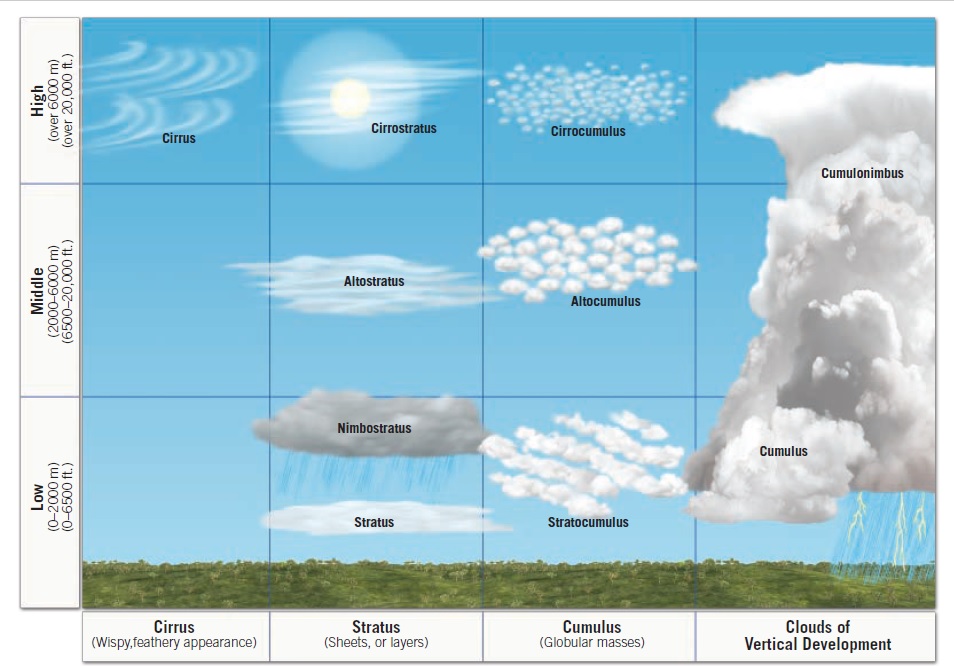
REVIEW FOR TEST 2 CHAPTER 3 - 4 AND 5.
1. WATCH THE VIDEOS FOR EACH CHAPTER BELOW ARE THE MOST IMPORTANT VIDEOS
2. Temperature Conversion - Remember the Formula - NO calculators on test. Remember how to get heatting and cooling degree days - 65 is the magic number. What is the Daily Mean?
3. Ocean Currents and Controls of Temperature. Temperature scales.
4. Chapter 4 - Stability and moisture
Remember Environmental Lapse rate tells us the temperature of the atmosphere but also the rate of colong or warming.
LCL - Lifting Condensation Level - This is where the atmosphere becomes saturated
(RH=100%) and clouds form.
The colder the atmosphere gets the more unstable the atmosphere is.
What is difference between relative Humidity and Dew Point.
State of water - Pages 85 - 87 States of Water *********very important.......
How many calories? What are the changes in the state of water called?
Four mechanisms that cause air to rise are PAGES 97 -100
(1) orographic lifting, where air is forced to rise over a
mountainous barrier,
(2) frontal wedging, where warmer, less dense air is forced over cooler, denser
air along a front,
(3) convergence, a pileup of horizontal air flow resulting in an upward flow,
and
(4) localized convective lifting, where unequal surface heating causes localized
pockets of air to rise because of their buoyancy.
The three fundamental conditions of the atmosphere are******* important....
(1) absolute stability, when the environmental lapse rate is less than the
wet adiabatic rate,
(2) absolute instability(UNSTABLE), when the environmental lapse rate
is greater than the dry adiabatic rate,
(3) conditional instability(UNSTABLE), when moist air has an environmental
lapse rate between the dry and wet adiabatic rates.
The temperature decrease in the troposphere, the bottom layer
in which we live, is called the environmental lapse rate. Its average value
is 6.5°C per kilometer,(3.5/3.6 F per 1000 feet) a figure known as the
normal lapse rate. The environmental lapse rate is not a constant and
must be regularly measured using radiosondes.
VERY VERY VERY IMPORTANT -- READ PAGE 96 TO 105..
An important concept related to relative humidity is the dew-point
temperature (or simply dew point), which is the temperature to which a parcel
of air would need to be cooled to reach saturation.
Unlike relative humidity, which is a measure of how near
the air is to being saturated, dew-point temperature is a measure of the air's
actual moisture content.
Example: IMPORTANT**********READ BELOW.........
Lapse rate 5C, Dry =10C Wet 6C = Absolute Stability
Lapse rate 12C, Dry =10C Wet 6C = Absolute InStability (UNSTABLE)
Lapse rate 9C, Dry =10C Wet 6C = Conditional InStability(UNSTABLE)
If the environmental lapse rate is less than the Wet Lapse Rate - the state of the air/atmospshere is STABLE
If the
environmental lapse rate is greater than the Dry Lapse Rate - the state of the air/atmosphere is UNSTABLE
If the Air Parcel is WARMER than the Environment - the atmosphere at that level is UNSTABLE.
If the Air Parcel is COLDER than the Environment - the atmosphere at that level is STABLE
PAGES 100-106 VERY IMPORTANT - figures 4.24, 4.25 and 4.26 ***** PAGES 102-103 FOR FIGURES********
Chapter 5 part 1
Chapter 5 part 2
Nimbo/Nimbus -- Rain Cloud, Dark gray
Clouds of Vertical Development - Cumulus and Cumulonimbus. They
develop into towers or domes.
-- Important go over Page 117 - Page 118 table 5.1 -
CLOUDS BASED ON FORM AND HEIGHT!!!
The three basic cloud forms are cirrus (high, white, and thin), cumulus (globular, individual cloud masses), and stratus (sheets or layers).
Cloud heights can be either
High, with bases above 6000 meters (20,000 feet) -- Cirrus
Middle, from 2000 to 6000 meters -- Alto
Low, below 2000 meters (6500 feet) -- Stratus
Based on the two criteria, TEN basic cloud types, including cirrostratus,
altocumulus, and stratocumulus, are recognized.
PRECIPITATION
LOOK AT PAGE 129-132 - VERY IMPORTANT..
VERY IMPORTANT TOPIC--
How can we measure Precipitation?
Simple rain gauge - Standard rain gauge, tipping-bucket gauge to measure rainfall.